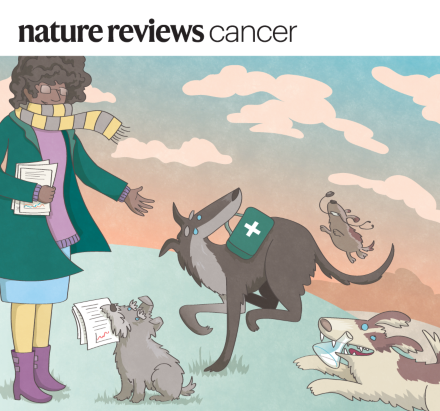The Comparative Oncology Program complements translational research efforts through the characterization and use of relevant and naturally occurring cancer models that develop in pet animals.
Mission: The COP provides an example of an integrated comparative oncology program and a mechanism by which naturally occurring cancer models can be used to generate new information about cancer, translate biological concepts regarding cancer to relevant in vivo models, and bring novel therapeutic options to the management of human cancers.
Research Goals
Canine-Specific Reagents
Develop an essential reagent kit for studying comparative models in translational and biology-based research.
- The shortage of species-specific reagents has limited opportunities to maximally use comparative cancer models in cancer research
- Advances in genetics, molecular biology and protein chemistry have lowered the hurdles associated with developing and efficiently producing canine-specific reagents
The Comparative Oncology Trials Consortium
The Comparative Oncology Trials Consortium (COTC) is an active network of nineteen academic comparative oncology centers, centrally managed by the NIH NCI Center for Cancer Research's Comparative Oncology Program. COTC designs, implements and manages preclinical trials involving pet animals to evaluate novel therapeutic strategies for cancer.
The Value of Comparative Oncology Models for Human Cancer
COP seeks to increase the awareness of naturally occurring cancer models in the cancer research community.
Many factors contribute to the value of spontaneous animal cancers as relevant models for human cancer:
- Like human cancers, these initially respond to several therapeutic approaches, but many of these approaches ultimately fail at the primary tumor site or at distant sites
- Comparative studies show a pattern of predictable progression similar to that seen in human cancers but nearly impossible to achieve in conventional mouse models
- Humans and pet animals share aspects of tumor biology, tumor behavior and, in some cases, have identical tumor histology and response rates to conventional chemotherapy
- Humans and pet animals share many environmental risk factors
- Animal cancer prevalence is sufficient to initiate and complete clinical trials rapidly
- Multimodality protocols are feasible due to the size of dogs and cats; this includes novel approaches to canine patient imaging
- Lack of gold standard treatments for pets allows early and humane evaluation of novel therapies
Improving human cancer therapy through the evaluation of pet dogs
Comparative oncology clinical trials play an important and growing role in cancer research and drug development efforts.
